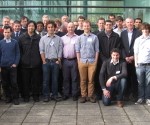The Engineering Nonlinearity Half-Yearly meeting took place at the Institute of Sound and Vibration Research (ISVR), University of Southampton on 7th and 8th January. The first full week of the New Year saw nearly 50 attendees gathering to discuss progress thus far and future plans on this EPSRC-sponsored Programme Grant, which runs from September 2012 to August 2017. It was especially pleasing to have such a good representation from the project’s Industrial Supporters; also some international members of the steering committee, who chose to attend this meeting over and above their commitment to attend the yearly review meetings in June each year.
The Keynote Lecture was given by Prof. Jim Woodhouse of the University of Cambridge – “Engineering Nonlinearity? Musical instruments have been doing it for centuries”, showing that musicians have been embracing nonlinear effects for hundreds of years.
Local host Prof. Steve Elliott and his team at ISVR then conducted tours of their long-established and impressive facilities, including many practical demonstration systems ranging from long-throw energy harvesters to their pioneering work on cochlear implants.
Day 1 continued in the afternoon with updates on the activities across the six programme themes, followed by lively discussion which carried on into the evening at Cowherds restaurant nearby. A large subset of the attendees nearly didn’t make it to the Cowherds, however; having stayed on in the meeting room to hear an extra talk from Project Leader David Wagg on Lie Group Analysis they were locked in as the last people in the building with no local hosts in attendance! Having been locked out of the meeting Prof. Keith Worden from the University of Sheffield saved the day by finding a local colleague who was able to let everyone out, with the Lie Group talk unfortunately unfinished!
Day 2 started with a presentation from Peter Court of Agusta Westland, one of the project’s Industrial Partners, who outlined some of the design and test considerations for helicopters and some of the implications of nonlinear behaviour.
Presentations for the rest of the day continued with contributions from PhD students and researchers associated with the project. A feature of all of these presentations was the clear and concise way the work was presented in the slots available, which allowed the nine presenters to showcase their work with enough time for discussions following each talk.
An excellent wrap-up and summary discussion was facilitated by Prof. Alan Champneys from the University of Bristol, channelling some of the techniques learnt at the Creativity at Home sessions from October 2013. The results of this session will provide food for thought for the Management Committee ongoing.
After lunch individual break-out groups carried on the discussions, including one facilitated by Peter Court and Trevor Walton of Agusta Westland, and the conclusion of Prof. Wagg’s Lie Group session!
Overall an excellent start to the year, which saw project engagement with the Industrial Partners move to a practical engagement phase.
